The Past and Future of Boston’s Franklin Park
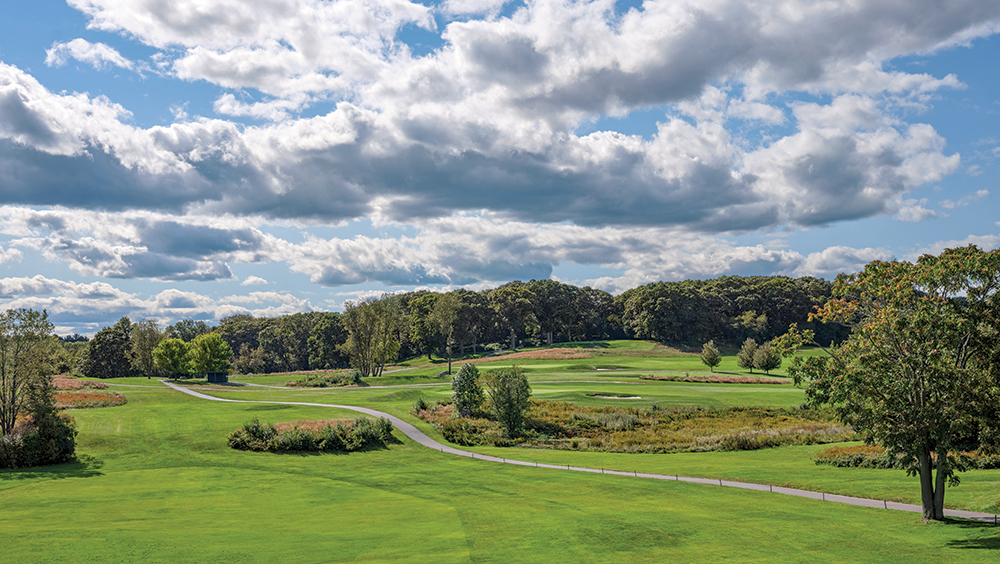
When Frederick Law Olmsted relocated his family and office from New York to Massachusetts in 1881, he did so while undertaking the most complete and innovative park system he would design. Known much later as Boston’s “Emerald Necklace,” the connected series of public landscapes pioneered urban planning ideas that today are described as “green infrastructure” and “landscape urbanism.” Olmsted had advised Boston’s park commissioners since 1875, and he designed his first park for them three years later. But he hesitated to move to the area until 1881. That year the city authorized funding to acquire over five hundred acres of land for what was at first called West Roxbury Park, the largest in the new system. This commitment was the final impetus for Olmsted’s move to the area and eventually to the farmhouse in Brookline that served as both family home and professional office. In 1885 the commissioners approved Olmsted’s design for West Roxbury Park and also renamed it Franklin Park, in honor of native son Benjamin Franklin.
The Boston commissioners had published their first park system plan in 1876. The chair of the commission, Charles H. Dalton, had been particularly interested in what Olmsted thought of the chosen location in West Roxbury for the city’s “large park.” This was an area of about two dozen small farms, orchards, and woodlots, seven miles from downtown Boston. West Roxbury had been an independent town until its annexation in 1873, and what they proposed was more of a suburban reservation than a “central” park. Olmsted had begun his career as a landscape architect almost thirty years earlier by addressing the notoriously unpropitious conditions of Central Park in the center of Manhattan. The Boston park site, however, was scenic and undeveloped: upland pastureland surrounded by higher, wooded ledges of Roxbury puddingstone. In an 1876 letter to Dalton, Olmsted wrote that “the locality seems to possess more advantages for the purpose [of a large park] than any other I have seen near Boston. . . . This is the only ground you propose to take on which it is practicable to form a park properly so called.” With Olmsted’s affirmation secured, Dalton published the initial park system plan, including the Franklin Park site, just weeks later.
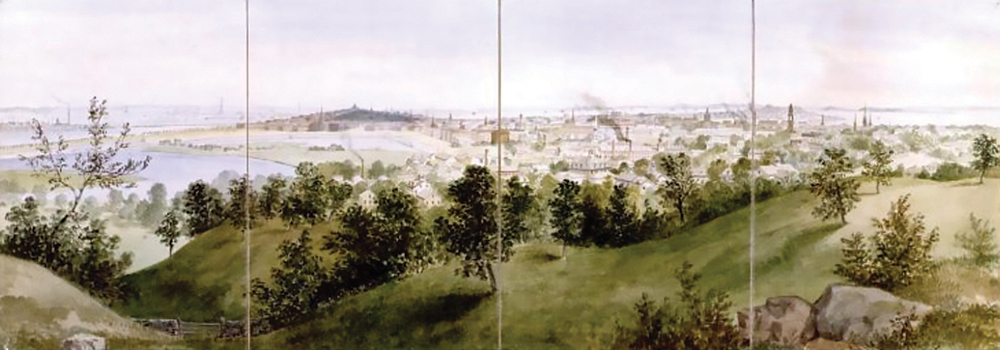
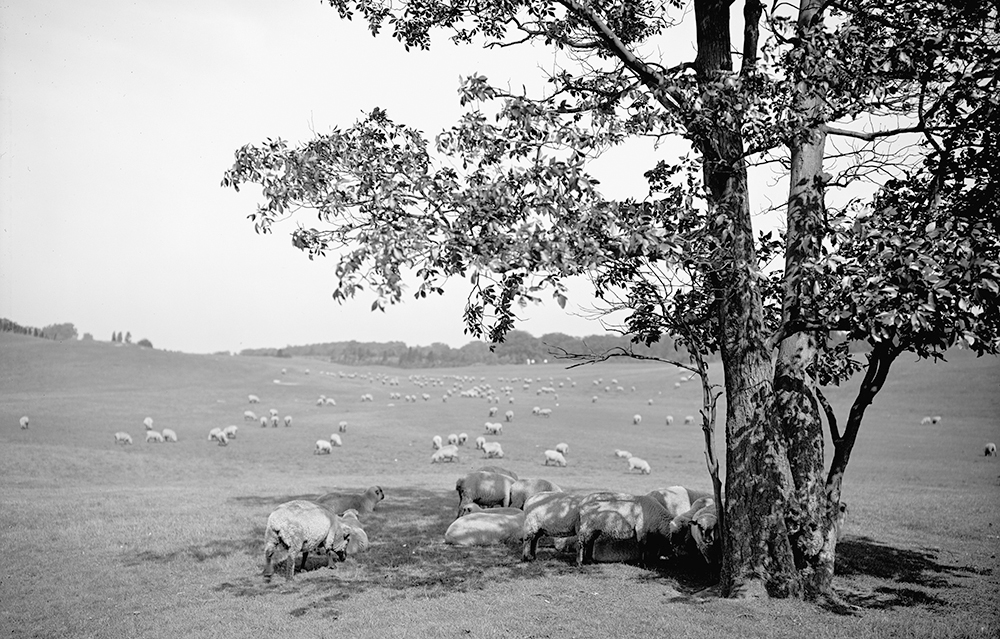
Olmsted’s 1885 plan for Franklin Park was delayed until surveyors completed a detailed topographic survey. But the existing site was already attracting thousands of visitors in 1883, and Olmsted oversaw interim improvements to serve them. He later wrote that “little more than the removal of artificial features” (such as fences, hedgerows, and outbuildings) had been required “to open the pleasing landscapes” to the early crowds. “Large picnics of school-children” and “games of ball and lawn tennis” were frequent in areas prepared for them. Temporary “shelter houses” were built on high points—the future locations of Schoolmaster, Hagborne, and Scarboro Hills. The temporary wooden pavilions were designed by Olmsted’s Brookline neighbor and frequent collaborator in the early 1880s, Henry Hobson Richardson. A plant nursery was established in the park, and a nearby house was converted for use as an on-site design office as well as a residence for William L. Fischer, Olmsted’s “assistant landscape gardener.”
Construction on permanent park structures, paths, and drives did not begin until 1887, delayed in this case by a dramatic change in Boston’s municipal government. Hugh O’Brien, who had emigrated from Ireland as a child in the 1830s, was elected mayor in 1884. The first Irish mayor of Boston, he appointed his Democratic supporters to various official positions after taking office the following February. The Republican park board, under Dalton, approved Olmsted’s annotated “General Plan of Franklin Park” in April 1885. O’Brien installed a new board in May, however, and they would now decide the fate of the project. The election of an Irish Catholic immigrant mayor caused much trepidation among the city’s “Brahmin” class, and Olmsted at first worried that his park plans would be derailed by the kinds of interference he knew all too well from New York. But Boston’s new mayor proved to be the savior of Franklin Park.
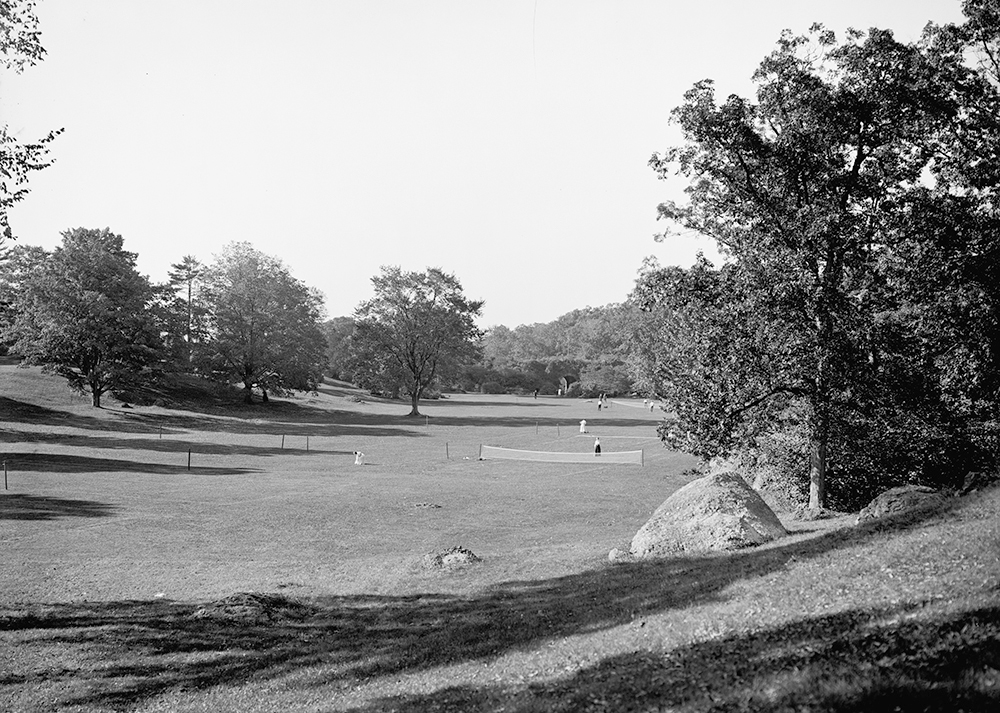
The Republican-dominated board of aldermen, fearing corruption and perhaps wishing to deny their opponents the success of a major public work, denied appropriations for construction for most of 1885 and all of 1886. O’Brien pushed ahead nevertheless and submitted a bill to the state legislature to authorize municipal bonds and bypass the appropriations process, allowing construction to begin in 1887. O’Brien also dispelled any concerns over how the money was spent. In January 1889, Olmsted remarked in a speech to the New England Club that neither patronage nor corruption had marred the work on Boston’s parks under “the former republican and present democratic administration.” Even after the “political revolution” three years earlier, Boston had been well served by disinterested and effective park commissioners. He added that “no other park work [had] come so nearly to be recognized and treated as a work of art” by any park commission in the country.
By the summer of 1889, much of Franklin Park had been completed. The Playstead area, devoted to “schoolboy” sports and large gatherings, was officially opened in June. The Country Park section, including the pastoral valley called the Nazingdale and the wooded promontory of the Wilderness, was also largely complete. Construction continued on drives, paths, and bridges, and when Olmsted retired in 1895, most (not all) of the 1885 plan had been implemented.
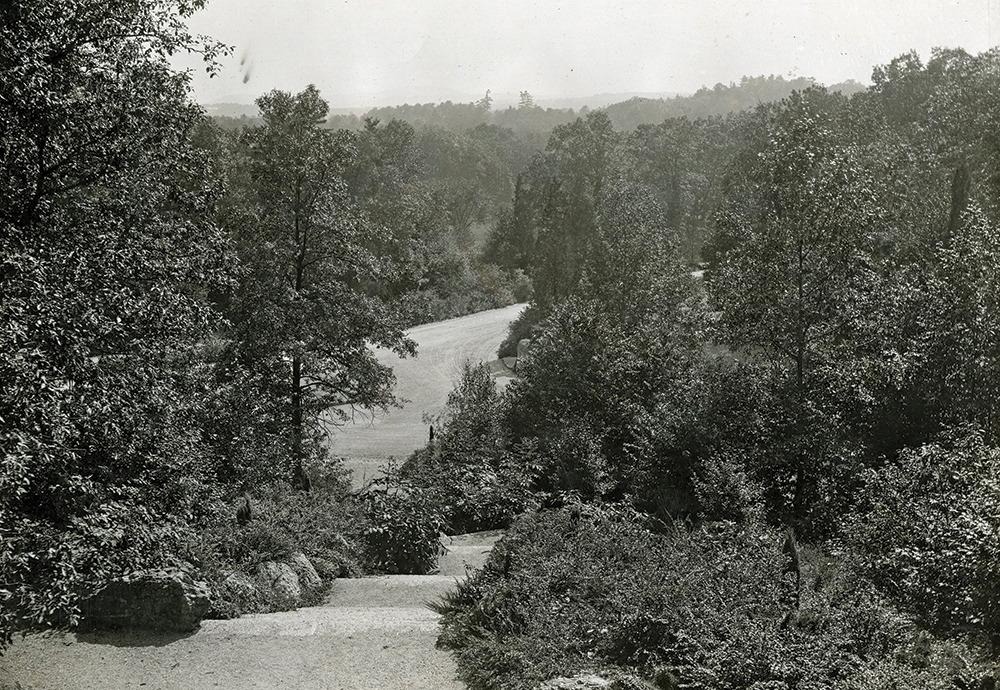
Olmsted envisioned Franklin Park as a setting for “receptive recreation,” which he defined as leisure activity “pursued socially or by a number of people together” but not as a structured sport or game. It might be “gregarious,” in which people enjoyed the spectacle of “congregated human life,” or “neighborly,” in which smaller groups and individuals gathered “under circumstances . . . favorable to a pleasurable wakefulness of the mind” for almost any “social . . . unexertive form of recreation,” such as family excursions and picnics, lovers’ walks, and children’s play. He felt that an expansive and unadorned “rural” landscape was the ideal setting for such unstructured, relaxing, friendly socializing. Other parts of the park system—including neighborhood playgrounds, smaller parks, and ballfield complexes—accommodated more “exertive recreation,” such as adult and team sports. They could also display monuments and formal gardens, serve as the settings for museums and libraries, and be located within crowded downtown neighborhoods.
But Franklin Park would be preserved as a passage of rural New England scenery—close to what had been. Improvements would be based on the existing character and features of the site, such as the valley of the Nazingdale, the “hanging woods” around it, and the outcrops of puddingstone that abounded. Paths and drives were engineered to minimize earthmoving and give sequential views of an enhanced version of the site as it had existed, unadorned by gardens, statuary, or obtrusive architecture.
The result deserves to be considered, with Central Park and Prospect Park, as one of the three greatest large parks Olmsted designed. Franklin Park was the last of the three, and it was the more mature expression of the landscape architect’s developing art and intentions. The existing West Roxbury site, and the collaborators and clients for the project, allowed Olmsted to achieve more completely a true pastoral expanse—the “pleasing rural scenery” he sought to preserve and enhance—than was possible in either the New York or Brooklyn parks.
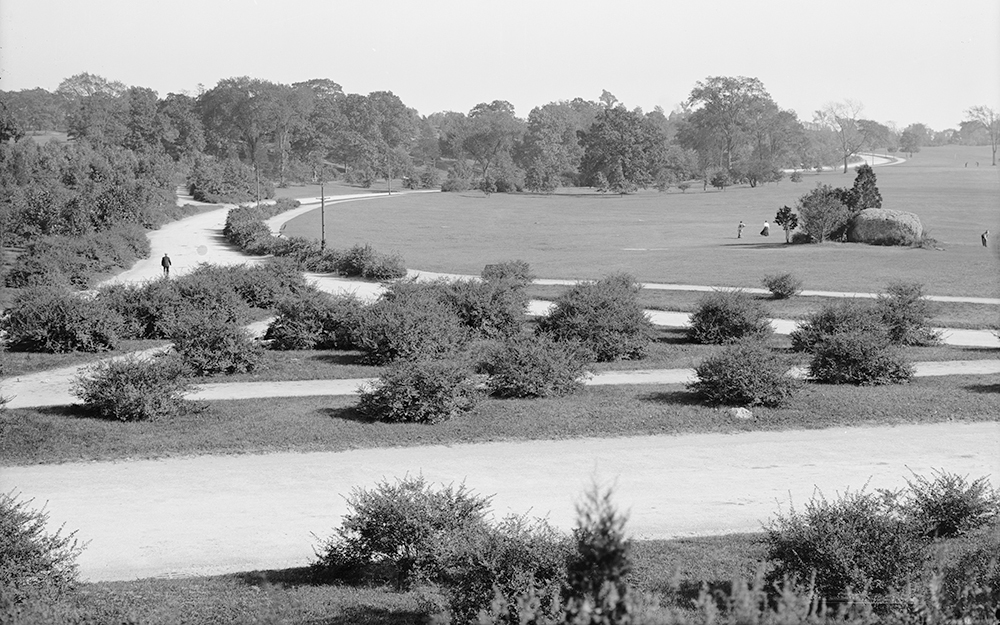
But if Franklin Park can be considered Olmsted’s most complete and successful pastoral or rural park, it also raises questions about how the park has been used since it was created, and how it has been adapted to meet the needs of the twentieth- and twenty-first-century city. Olmsted retired before the Greeting section was constructed. The Greeting was intended to be a half mile, elm-lined promenade leading into the park from Blue Hill Avenue. A large restaurant, a concert ground, playgrounds, and zoo exhibits were all to be part of this heavily programmed area, naturally separated from the Country Park by the site’s glacial topography. The Greeting was essential because it was planned as the park’s principal gathering place, featuring the attractions and activities that would draw people into the park and provide for the more “gregarious” aspects of receptive recreation. Without it, the park drew fewer visitors than anticipated. The Olmsted firm’s involvement mostly ended, and new management policies minimized expenses, shifting exclusively to maintenance and horticultural concerns.
Historians have interpreted the dearth of visitors at the start of the new century as a rejection of the large pastoral park. As organized recreation became increasingly popular, Boston’s park policies after 1895 indeed favored playgrounds and ballfields, responding to public demand. An improvised golf course was laid out in the Nazingdale in 1896, and golf has remained popular in Franklin Park ever since. But the modern enthusiasm for more “exertive” recreation never negated the need—or the popularity—of more “receptive” activities in less-developed park landscapes. By the early twentieth century, for example, more Bostonians used trolleys, and later cars, to leave the city altogether and enjoy the new metropolitan “reservations” being created in scenic areas farther from town.
The value and benefit of an expansive and “natural” landscape accessible to all people—the core precept of Olmsted’s landscape theory—should not be dismissed as a dated or elitist idea. Social science research of the last several decades has confirmed that access to “nature” is in fact a vital factor in promoting physical and emotional well-being, especially in cities. Without the Greeting, however, Franklin Park remained unfinished, and for a period it was not used to a degree commensurate with its position as Boston’s largest park.
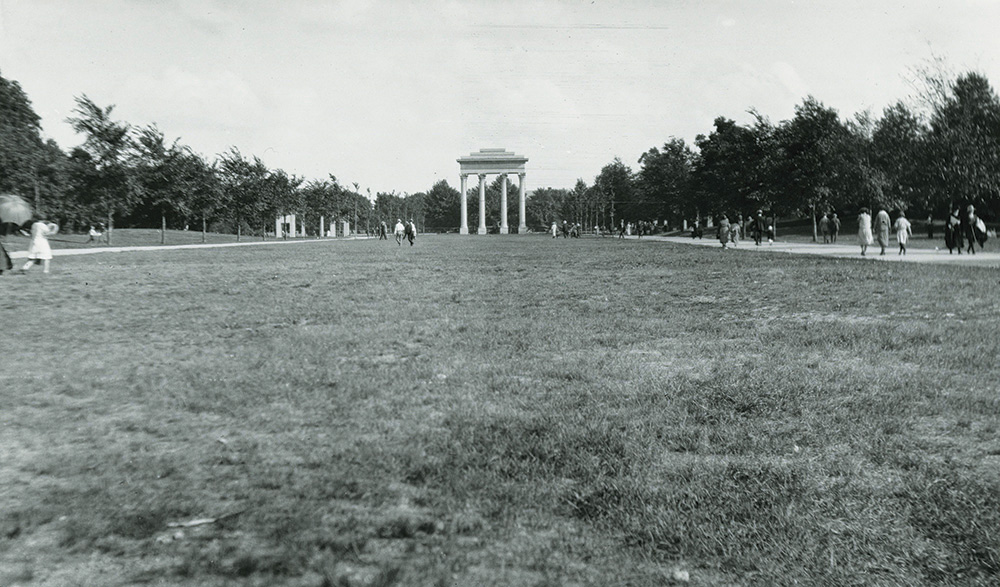
A new vision for adapting—really, completing—the park was needed, and after 1910, Mayor John F. “Honey Fitz” Fitzgerald provided it. He had the benefit of a new chair of the park commission, Robert Swain Peabody, who was one of the most prominent architects of the era. Earlier in his career, Peabody had collaborated with Olmsted on many significant projects, and he made the completion of Franklin Park his first priority. To do so, he revived the idea of the Greeting in a new form. The park commission hired a former Olmsted apprentice, Arthur A. Shurcliff, who designed a large new zoo on the proposed footprint of the unbuilt Greeting. The plan organized the buildings and exhibits around the half-mile promenade, thus combining the needs of a modern zoo with the functionality of a major pedestrian entrance and point of congregation for the park. First opened in 1912, the Franklin Park Zoo was unfenced and free to the public, and so served the planned function of the original Greeting by attracting large crowds into the park. Once entering the zoo, visitors could gather and proceed down the new Greeting to the Playstead and the Country Park beyond. Franklin Park was finally finished. Adapted to the needs of the new century, it enjoyed a heyday of popularity with millions of visitors a year recorded by the 1920s.
Franklin Park did suffer an existential crisis. But the reasons for its quandary had nothing to do with changing trends in public recreation, nor did they result from any conjectured failures of the park’s original design and purpose. During the decades following World War II, the neighborhoods around the park experienced a dramatic demographic shift, often described as “white flight.” With startling rapidity, white residents moved out, usually to more distant suburbs. Black people moved in, along with groups of immigrants from the Caribbean and elsewhere. There were of course many dire implications of this period of urban history. In the case of Franklin Park, an official disinvestment occurred. Once Franklin Park was perceived as a place for Black people, city government no longer considered it worth maintaining, and the condition of the park deteriorated.
Official policies abandoned not only the park but entire portions of the city. The root cause of the park’s dilemma at midcentury was the institutional racism that affected many aspects of urban politics and government policy at the time. It would be up to the people who lived around the park and used it to determine its future.
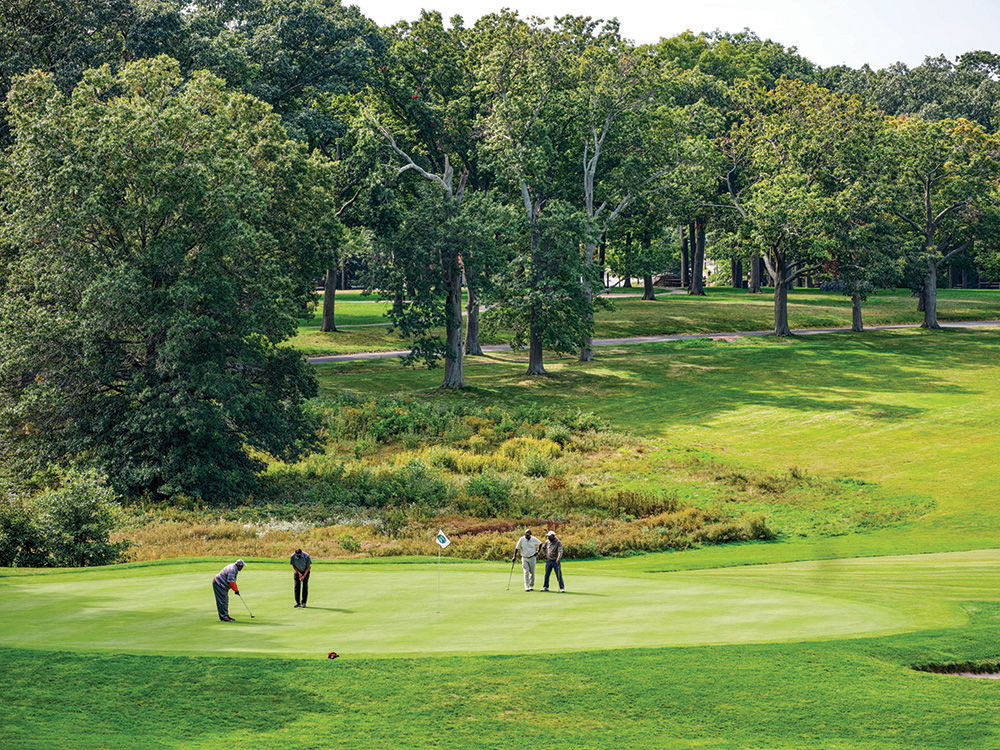
The 1970s were a turning point, as the communities around Franklin Park organized to do what the city would not. The arts educator Elma Lewis and her students cleared an overgrown area in the Playstead and built a stage, where from 1966 through 1978 concerts and theatrical performances were held every night during the summer, drawing thousands to the park. The tradition was revived in 2003 and continues today as the Elma Lewis Playhouse in the Park. A group of local golfers, organized as the Franklin Park Golf Association, revived their golf course. They later successfully lobbied the city to fully rehabilitate the course and build a new clubhouse.
Lewis and Richard Heath cofounded the Franklin Park Coalition in 1971, and with Heath as executive director, the coalition of neighborhood residents would have a decisive influence on the future of Franklin Park. Local park advocates assembled volunteers to improve the condition of the landscape. They researched its history, published guides and other information, and helped secure the park’s designation in 1980 as a Boston Landmark for its significance as a work of landscape architecture. The Franklin Park Coalition has continued to organize community events for the last fifty years, including its annual Kite & Bike Festival in the Playstead, charity runs, and public fitness initiatives. Through community organization and advocacy—above all, through the use and appreciation of the landscape by the people who lived around it—Franklin Park survived official neglect and continued to be a vital and beneficial part of life for Bostonians.
In recent years, city officials have also awakened to the need to support community initiatives with public spending that addresses, belatedly, the inequity of mid-twentieth-century disinvestment. In 2018 a major new source of public funding was committed to the revitalization of Franklin Park, and consultants were then selected to lead a community-based planning process to guide future management and investment in the landscape. This commitment acknowledges that the continued success of Franklin Park will require significant and sustained public spending.
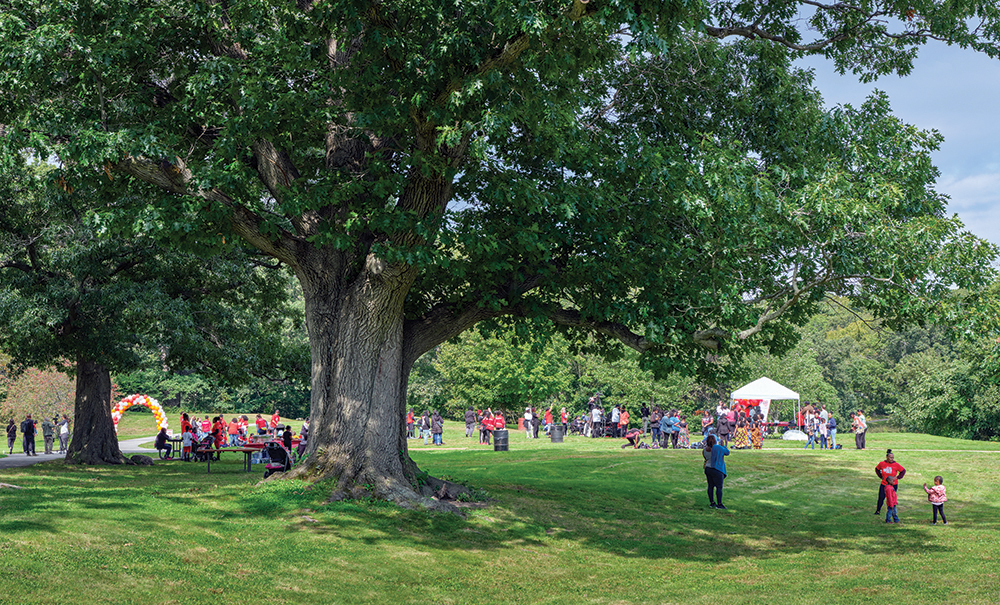
Since the 1980s, many large urban parks have benefited from the establishment of “conservancies” that have raised many millions of private dollars to fund landscape rehabilitation and management. Modeled on the first, the Central Park Conservancy, these private nonprofit organizations have been vital partners in an era of rebirth for Olmsted parks in particular. Many of Franklin Park’s peers are in better condition today than they have been for decades. But the conservancy model, as successful as it has been, cannot entirely replace a municipal commitment to public park systems. Not all parks can attract enough private money to sustain them, much less rehabilitate landscapes and fund better management. Franklin Park, seven miles from downtown Boston, is not lined with expensive residential towers or corporate headquarters and has never been the recipient of the largesse such neighbors can bestow.
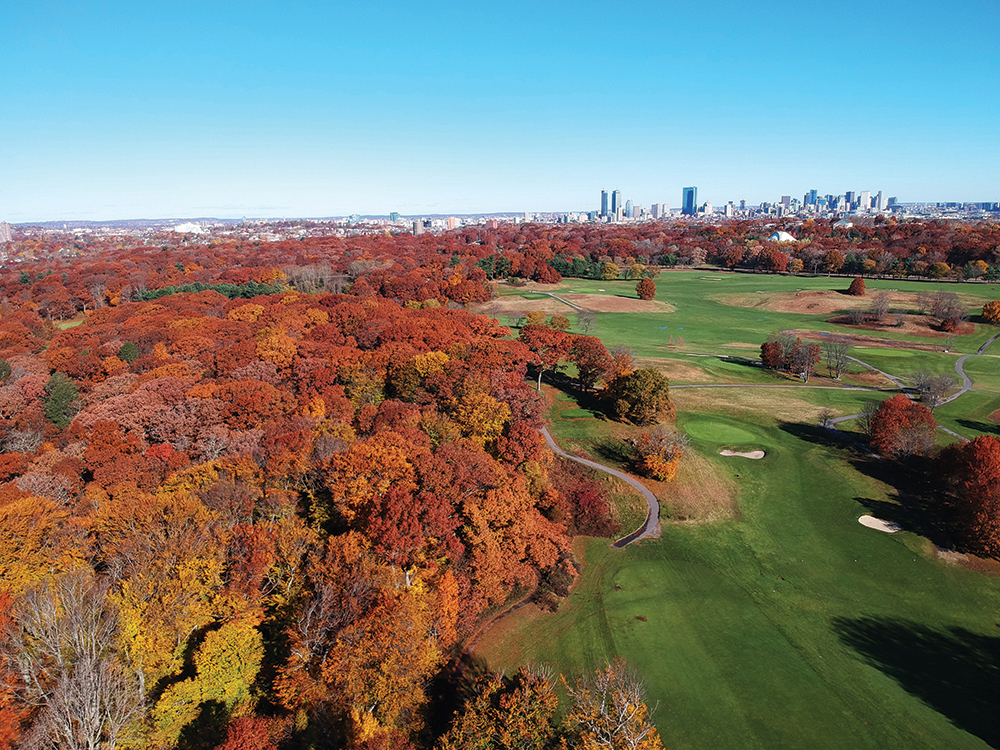
In any case, partial privatization through fundraising may not be possible—or desirable—for Franklin Park. Investments in public landscapes tend to raise property values, and so can contribute to the displacement of people in adjacent neighborhoods. For the communities around Franklin Park, who for over fifty years have made the park their own and mobilized to rescue it from official indifference, such an outcome would be unacceptable. The current planning process based in community engagement will be tasked with finding a new model for future management, one that will necessarily require enhanced and sustained public funding.
Planning for the future of Franklin Park offers an opportunity to develop a new model for the management of large urban parks. The time and the place demand moving beyond the conservancy model, even as nonprofit partnership remains essential to community engagement and park programming. The “action plan” under way for Franklin Park can be as influential as the Central Park Conservancy’s “management and restoration” plan, which began a new era for municipal parks over thirty years ago. Guided by community involvement and facilitated by a historic commitment of public funding, the revival of Franklin Park should be a similarly important beginning. The last of Olmsted’s three greatest urban park designs is poised, in this bicentennial year, to reclaim and amplify its position as one of the masterworks of American landscape architecture.
Ethan Carr, FASLA, is professor of landscape architecture at the University of Massachusetts Amherst. His books published by LALH include Mission 66: Modernism and the National Park Dilemma, The Greatest Beach: A History of Cape Cod National Seashore, Boston’s Franklin Park: Olmsted, Recreation, and the Modern City, and, as coauthor, Olmsted and Yosemite: Civil War, Abolition, and the National Park Idea.